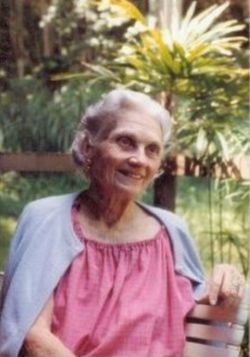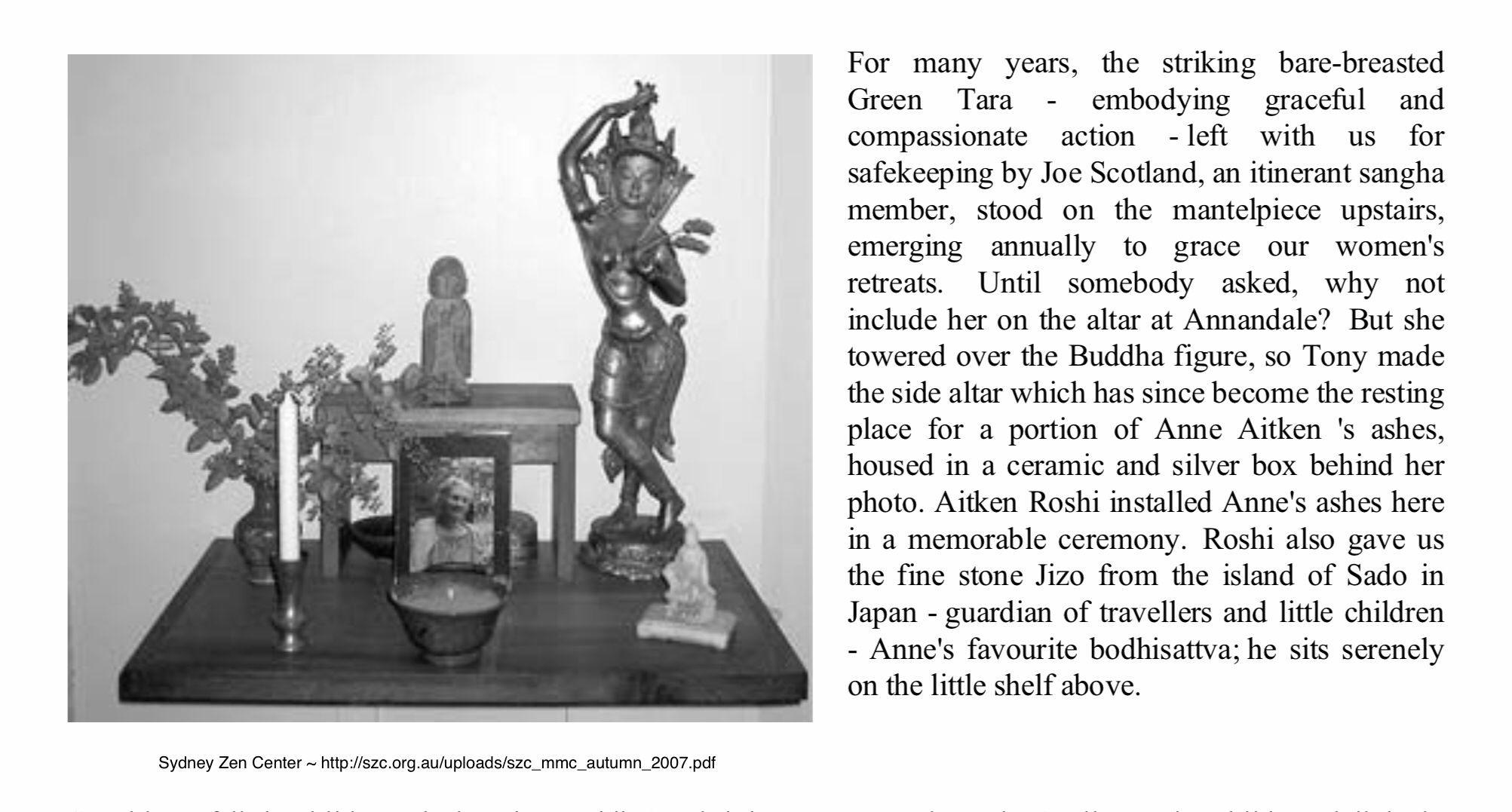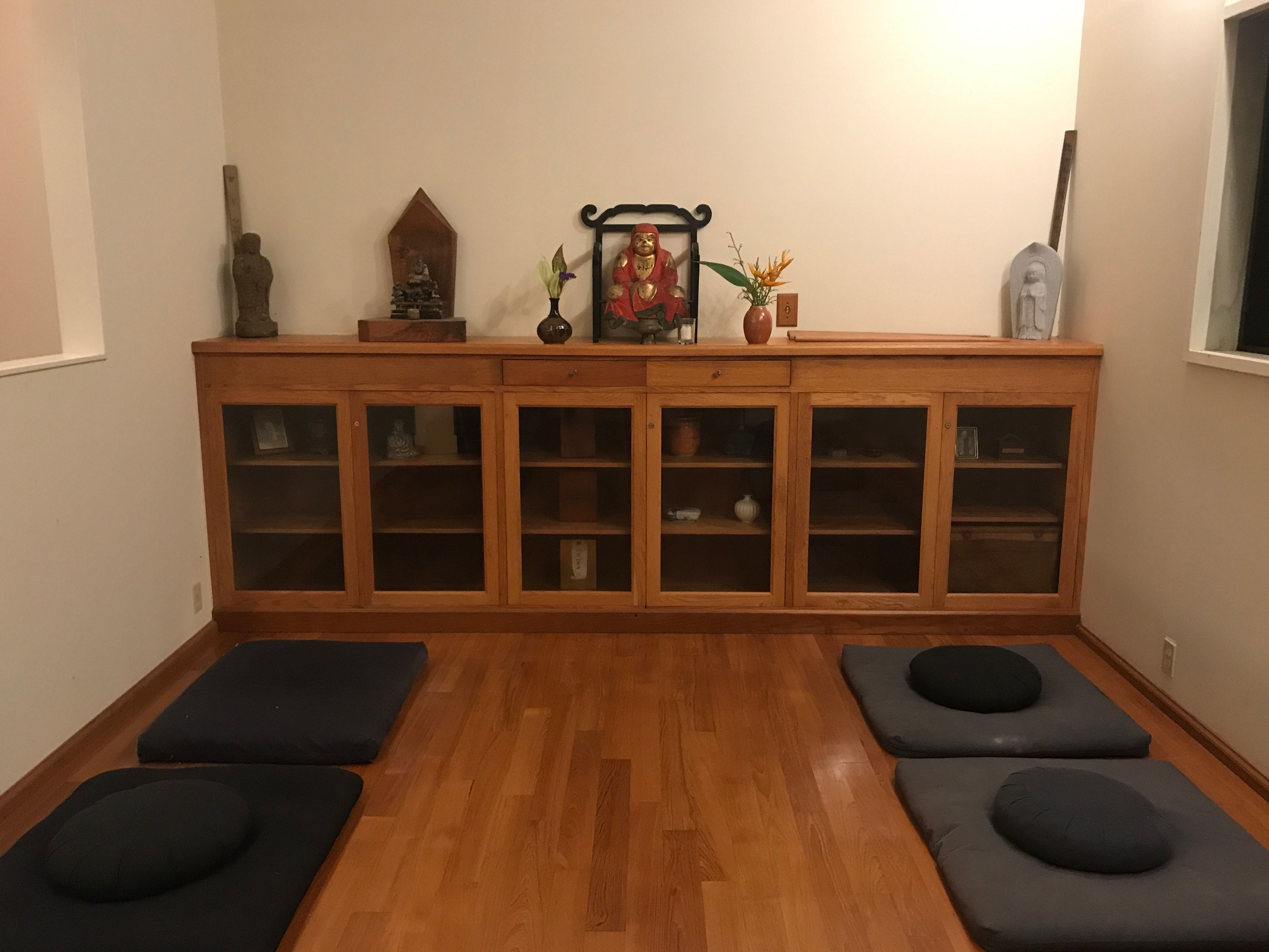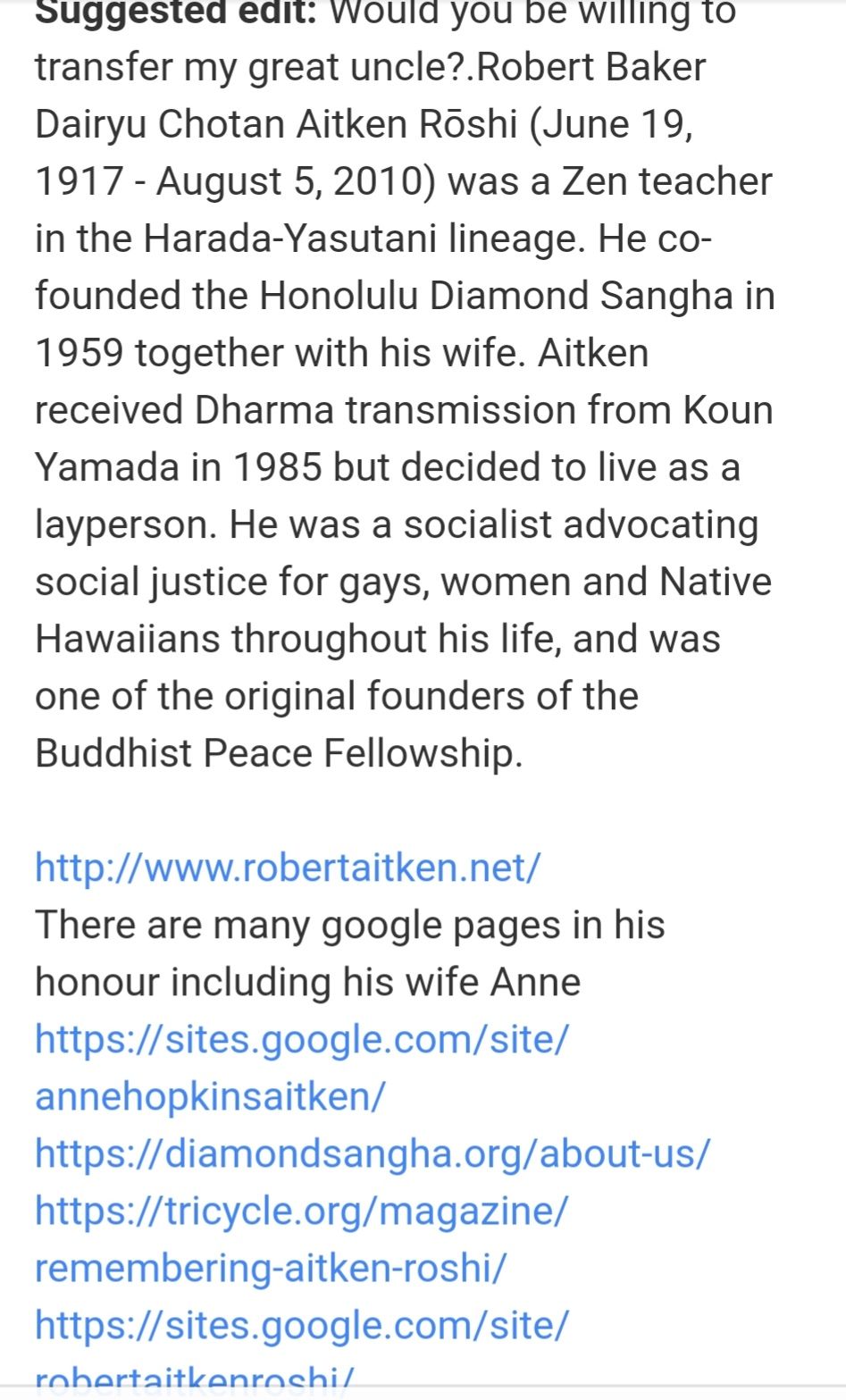Anne spent two years (1929-1931) studying abroad as an undergraduate at Oxford University and graduated from Scripps College in Claremont, California (B.A., English, 1932). She then pursued a Master's Degree in Sociology, first at Stanford University (1933), and later at Northwestern University (1940-1942). In addition to her Oxford years, she also lived in England from January to June, 1937, and at various times in her life traveled to Sweden, Finland, France, Germany, Spain, Japan, Italy and much of South America.
She was living at the teacher's quarters of the Honolulu Diamond Sangha in Palolo, Honolulu, Hawaii, when she became ill with flu symptoms and died of a coronary attack two days later, on June 13th 1994, with her husband, step-son, and a few close friends at her hospital bedside.
Anne Aitken died on June 13 of this year [1994] in Honolulu, with her husband Robert Aitken Rōshi, her stepson Tom, and Don Stoddard, friend and temple builder, by her side. She was 83. Anne is one of the mothers of modern Zen in the West. She is remembered best for her generosity with the gifts of life: encouragement, telephone calls, conversation, books, poetry, music--she liked to play the recorder with friends-tea and sympathy, tolerance, money, and more encouragement. Immensely gracious and strong, she helped guide several generations of Zen students. She had a fruitful and long Zen partnership with her husband, Aitken Rōshi. It began when, on their honeymoon trip to Japan, they stayed at Ryutakuji and went in to sesshin, without her understanding quite what a sesshin was. This is a story she told with a relish that reflected both her delight in absurdity as well as her ultimate pleasure in the dharma. In 1959 she helped found the Koko An Zendo in her living room in Hawaii; it became the foundation temple of the Diamond Sangha--now an international association with many temples.
She studied with some of the great teachers of her time--Soen Roshi, Yasutani Roshi, Yamada Koun Roshi--and helped bring them to the West to teach. Her early studies were in art, literature, and social work, and these influences can be seen in her later Zen work. In the Maui Zendo she was tough enough to run the work crews and help a band of undisciplined and unfocused young people to function and to discover Zen.
She traveled to Sweden, Finland, France, Germany, Spain, Japan, Italy, México, and much of South America before becoming a teacher and assistant director at Happy Valley School in 1949. There she met, and in 1957 married, English teacher Robert Aitken.
Her new husband introduced her to Zen Buddhism, and her long relationship with the Buddhist community began with their honeymoon to Ryutakuji in Japan. She went on to study the Dharma with Haku'un Yasutani, Sōen Nakagawa and Koun Yamada. She was given the Japanese Buddhist name An (Peace, peace of being at home) Tanshin (Single mind). She and her husband moved to Honolulu, Hawaiʻi, to be closer to her young stepson.
Anne inherited money, and it seemed the only interest she could find in it was to be a benefactor of Buddhism and social causes. She had a great empathy for the poor, disadvantaged, and just plain eccentric. She acted as if people would live up to her standards of service and civility, and mostly they did. She loved people into being dedicated and even courteous.
Maui Zendo was one of the early temples in the West where you could do hard training, and without Anne it couldn't have come to be. In countless sesshins, she inspired us in her particular fashion. She conveyed her understanding of Zen by her presence, her floating, dance-like walk, her welcoming words, so consistently dazzling and intimate that they were like an embrace, her sense that a beautiful heart and beautiful things and beautiful actions were all on the one thread, her serenity, humor, and perseverance; these were her teachings. She deflected flattery and even sincere praise; she saw her gifts as those of service and loyalty. She was particularly encouraging to senior women, telling them, "Yes, you can do it, you'll do it very well," when they took on a new responsibility. The importance of this support cannot be underestimated. She liked to be in the background herself, but did not believe that others should be.
Her final gift was her candor about the approaching end.
Her image for death was this: 'We are waiting at a bus stop - our bus comes along and we get on....' ------ John Tarrant
Roshi has placed Anne's ashes in a beautiful pottery container on the altar, just below Manjusri.
https://sites.google.com/site/annehopkinsaitken/
Manjusri is the bodhisattva of wisdom and is one of the most important iconic figures in Mahayana art and literature.
Palolo Zen Center Columbarium
Cremated, assume ashes with family. Roshi has placed Anne's ashes in a beautiful pottery container on the altar, just below Manjusri.
Anne Arundel Stinchfield "An Tanshin; Anna" Hopkins Aitken changed Nov 2nd 2019 Contributor:Tom Aitken (50134703)
Anne's cremains (as well as those of husband Robert's) are divided between columbaria at the Pālolo Zen Center in Hawaiʻi, the Sydney Zen Center in Australia, and a family alter.
(http://szc.org.au/uploads/szc_mmc_autumn_2007.pdf)
Contributor: Tom Aitken (50134703) •
Anne spent two years (1929-1931) studying abroad as an undergraduate at Oxford University and graduated from Scripps College in Claremont, California (B.A., English, 1932). She then pursued a Master's Degree in Sociology, first at Stanford University (1933), and later at Northwestern University (1940-1942). In addition to her Oxford years, she also lived in England from January to June, 1937, and at various times in her life traveled to Sweden, Finland, France, Germany, Spain, Japan, Italy and much of South America.
She was living at the teacher's quarters of the Honolulu Diamond Sangha in Palolo, Honolulu, Hawaii, when she became ill with flu symptoms and died of a coronary attack two days later, on June 13th 1994, with her husband, step-son, and a few close friends at her hospital bedside.
Anne Aitken died on June 13 of this year [1994] in Honolulu, with her husband Robert Aitken Rōshi, her stepson Tom, and Don Stoddard, friend and temple builder, by her side. She was 83. Anne is one of the mothers of modern Zen in the West. She is remembered best for her generosity with the gifts of life: encouragement, telephone calls, conversation, books, poetry, music--she liked to play the recorder with friends-tea and sympathy, tolerance, money, and more encouragement. Immensely gracious and strong, she helped guide several generations of Zen students. She had a fruitful and long Zen partnership with her husband, Aitken Rōshi. It began when, on their honeymoon trip to Japan, they stayed at Ryutakuji and went in to sesshin, without her understanding quite what a sesshin was. This is a story she told with a relish that reflected both her delight in absurdity as well as her ultimate pleasure in the dharma. In 1959 she helped found the Koko An Zendo in her living room in Hawaii; it became the foundation temple of the Diamond Sangha--now an international association with many temples.
She studied with some of the great teachers of her time--Soen Roshi, Yasutani Roshi, Yamada Koun Roshi--and helped bring them to the West to teach. Her early studies were in art, literature, and social work, and these influences can be seen in her later Zen work. In the Maui Zendo she was tough enough to run the work crews and help a band of undisciplined and unfocused young people to function and to discover Zen.
She traveled to Sweden, Finland, France, Germany, Spain, Japan, Italy, México, and much of South America before becoming a teacher and assistant director at Happy Valley School in 1949. There she met, and in 1957 married, English teacher Robert Aitken.
Her new husband introduced her to Zen Buddhism, and her long relationship with the Buddhist community began with their honeymoon to Ryutakuji in Japan. She went on to study the Dharma with Haku'un Yasutani, Sōen Nakagawa and Koun Yamada. She was given the Japanese Buddhist name An (Peace, peace of being at home) Tanshin (Single mind). She and her husband moved to Honolulu, Hawaiʻi, to be closer to her young stepson.
Anne inherited money, and it seemed the only interest she could find in it was to be a benefactor of Buddhism and social causes. She had a great empathy for the poor, disadvantaged, and just plain eccentric. She acted as if people would live up to her standards of service and civility, and mostly they did. She loved people into being dedicated and even courteous.
Maui Zendo was one of the early temples in the West where you could do hard training, and without Anne it couldn't have come to be. In countless sesshins, she inspired us in her particular fashion. She conveyed her understanding of Zen by her presence, her floating, dance-like walk, her welcoming words, so consistently dazzling and intimate that they were like an embrace, her sense that a beautiful heart and beautiful things and beautiful actions were all on the one thread, her serenity, humor, and perseverance; these were her teachings. She deflected flattery and even sincere praise; she saw her gifts as those of service and loyalty. She was particularly encouraging to senior women, telling them, "Yes, you can do it, you'll do it very well," when they took on a new responsibility. The importance of this support cannot be underestimated. She liked to be in the background herself, but did not believe that others should be.
Her final gift was her candor about the approaching end.
Her image for death was this: 'We are waiting at a bus stop - our bus comes along and we get on....' ------ John Tarrant
Roshi has placed Anne's ashes in a beautiful pottery container on the altar, just below Manjusri.
https://sites.google.com/site/annehopkinsaitken/
Manjusri is the bodhisattva of wisdom and is one of the most important iconic figures in Mahayana art and literature.
Palolo Zen Center Columbarium
Cremated, assume ashes with family. Roshi has placed Anne's ashes in a beautiful pottery container on the altar, just below Manjusri.
Anne Arundel Stinchfield "An Tanshin; Anna" Hopkins Aitken changed Nov 2nd 2019 Contributor:Tom Aitken (50134703)
Anne's cremains (as well as those of husband Robert's) are divided between columbaria at the Pālolo Zen Center in Hawaiʻi, the Sydney Zen Center in Australia, and a family alter.
(http://szc.org.au/uploads/szc_mmc_autumn_2007.pdf)
Contributor: Tom Aitken (50134703) •
Gravesite Details
cremains (as well as those of husband Robert's) are divided between columbaria at the Pālolo Zen Center in Hawaiʻi, the Sydney Zen Center in Australia, and a family alter.
Family Members
Sponsored by Ancestry
Advertisement
Records on Ancestry
Advertisement












